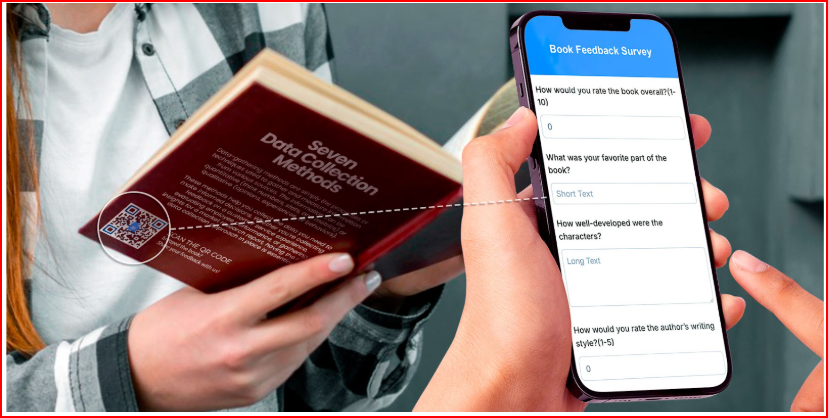Low Reader Input? These 8 Data Collection Methods Will Help

The absence of reader insight, often due to weak data collection methods, is more than just a missing line item on a post-launch checklist. It directly limits a book’s growth, reach, and future opportunities for both creator and publisher.
Many authors and publishers experience muted reader engagement, which leaves them guessing about what worked. This is a critical communication gap in the book market.
The remainder of this article focuses on solving that gap. We’ll explain reader insights and why they’re so often lacking, and, more importantly, walk through specific, effective data-gathering methods that bridge the distance between book creators and their audiences.
Plus, we’ll also give out a bonus tip on using a QR code form to make reader surveys more accessible.
What are reader insights, and why are they often missing?
Reader insights are observations—both emotional and structural—about how people respond to a book. They help uncover what resonated, what fell flat, and why.
When gathered with intention, these insights are incredibly useful. Authors get to know their audience better, which informs future writing. Publishers can spot patterns that shape stronger marketing and positioning. Even readers benefit—books shaped by real feedback often hit closer to home.
Yet, despite their value, reader insights are often missing from the publishing cycle. Why?
- Reviews Don’t Cut It: Only a small percentage of readers leave public reviews—and fewer still go beyond a star rating.
- Friction: Readers often don’t know how or where to share thoughts, or feel intimidated by public reviews.
- No prompting: Without direct asks or structured feedback systems, reviews stay scattered and underutilized.
Addressing this requires a deliberate shift from passive waiting to active collection, and that starts with using the right data collection methods for reader reviews.
Data gathering methods for low reader reviews
Survey method with QR code forms
One of the most effective ways to collect structured feedback is through reader surveys. These allow you to ask specific, targeted questions that reveal not only how readers felt about the book, but also why.
For instance, asking “Which character did you connect with most?” or “Were there any parts where the pacing felt slow?” yields insights that are far more informative than a generic rating.
Surveys also allow you to segment feedback, gathering different types of responses from first-time readers, genre fans, or long-time followers. When well-designed, survey methods provide both quantitative data (e.g., rating scales) and qualitative insights (open-ended responses).
And did you know there’s a more convenient way to conduct your surveys—without needing physical forms or direct contact? It’s possible through scannable online forms powered by QR codes. Here’s how you can create a QR form:
- Sign up for an online form builder to start creating your web forms.
- Choose a ready-made survey template or build one from scratch to suit your goals.
- Add key fields such as ratings, open-ended questions, and chapter-specific feedback.
- Finalize the survey and generate a QR code—customize it to match your book’s branding.
- Share the QR code via email, social media, book clubs, or place it inside your book (e.g., back matter or acknowledgments).
- Use the builder’s analytics tools to monitor scans and responses, and draw actionable insights from the data.
Email follow-ups
Email remains one of the most effective communication tools in publishing. By integrating post-read follow-up emails into your workflow, you can initiate a direct conversation at the right moment: when the reading experience is still fresh.
Advance Reader Copy (ARC) teams
ARC readers are a unique feedback group: highly engaged, often passionate, and typically willing to provide honest, early-stage feedback.
Book review pages
Creating a dedicated section on your website or author platform where readers can submit their thoughts simplifies the feedback process. This page should also offer a space for private or anonymous feedback.
End-of-book CTA page
A well-written call-to-action (CTA) page at the end of the book should direct readers to a feedback form or invite them to email the author directly.
Social media polls and direct messages
Polls on Instagram Stories or Twitter, question boxes, and comment threads can all serve as quick pulse checks.
Online communities and reader groups
Joining online book groups or genre-specific communities helps you get feedback from your target audience without being pushy.
By engaging genuinely, without pushing your book, you gain trust and learn what your target audience likes or dislikes in stories like yours. It’s a smart way to spot patterns and shape future work around real reader interests.
Incentive campaigns
Offering small rewards for feedback—such as exclusive content or early access to new material—can improve response rates.
Craft rich stories using the right data collection method
Low reader insights are not an unsolvable issue—they’re often the result of missing systems. Waiting around for reviews doesn’t cut it anymore.
Using Form Creator as your survey tool makes it easier to build reader review forms tailored to your audience. This small step can streamline how you collect and organize insights.
By understanding reader insights and applying practical methods for collecting them, creators can create more responsive, reader-aligned works.
Implement one approach, then refine it. Over time, this approach builds a feedback loop that strengthens your current project and becomes an asset for everything that follows.
The result? Better books. Stronger connections. And a more informed path forward.